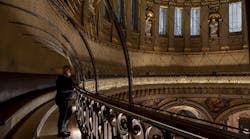I have always been a believer and practitioner in change, whether it be in career shifts (three to date), relocating (five states plus D.C. with intrastate moves in between), or mindset (I will look forward to exercising).
In a world that grapples to understand the next technology, standard, or trend, businesses have to be open to change if they have any interest in longevity. About a decade ago, I attended a lighting tradeshow in which the number of booths featuring LED products was just beginning to surpass those with conventional sources. As the wave of solid-state lighting sources lapped at our feet, one manufacturer said they firmly believed in their fluorescent products and that was all they planned to offer. Though their fluorescent fixtures were outperforming some of the nascent LED fixtures on display at the time, I couldn’t help but think, “You never know what the future holds.”
As it turns out, the future would see increased attention from the public and private sectors to mitigate climate change, to decrease embodied and operational energy use, and to eliminate toxic chemicals in consumer products. This would be accompanied by increased market demand for LEDs that would drive exponential gains in their performance and reliability.
This year, Vermont will become the first state to ban the sales of mercury-containing compact fluorescent lamps, with 4-foot linear fluorescent lamps to follow next year. California is up next with AB 2208 nixing the sales of CFLs in 2024 and linear fluorescent lamps up to 8 feet long in 2025. On the national front, the Department of Energy is doubling down on its 2022 rule to prohibit the sales of general service lamps (GSLs) with less than a 45 lm/W efficacy by proposing to raise the minimum luminous efficacy of GSLs to 120 lm/W. This would effectively preclude the use of CFL replacement lamps, which average 50 to 70 lm/W.
Along the same line, California’s Title 24, Part 6 now requires the installation of lamps in residential and hospitality interior applications to meet both energy and performance requirements, as outlined in its Joint Appendix 8, to help ensure end users receive quality lighting. See this issue’s article by Energy Code Ace for more details.
Beyond regulatory reasons, lighting designers are specifying LEDs for their projects’ diverse lighting needs and for pragmatic reasons. As Fisher Marantz Stone founding principal Paul Marantz put it when detailing the architectural lighting design at Lincoln Center’s recently renovated David Geffen Hall, “I might find old light sources appealing in some way, but it doesn’t matter because they are going to disappear from an availability standpoint.”
As for the company that once held firm to fluorescent technologies? It embraced change after all and thrives today with a mix of fluorescent and, you guessed it, LED products.
WANDA LAU is editorial director of LEDs Magazine and Smart Buildings Technology. She previously served as executive editor of Architect magazine and worked for a decade in the architecture, engineering, and construction industry.
For up-to-the-minute LED and SSL updates, follow us on Twitter. You’ll find curated content and commentary, as well as information on industry events, webcasts, and surveys on our LinkedIn page and our Facebook page.





